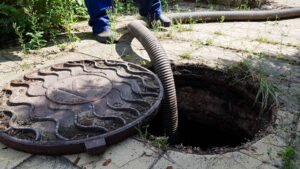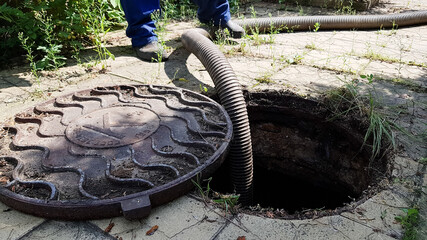Septic Tank Pumping Madera is essential to maintaining a properly functioning wastewater system. Over time, solid waste and sludge accumulate in the tank. If not removed regularly, this buildup can cause blockages and system failure. Proper maintenance ensures a longer lifespan and better performance of the septic system.

Septic tanks separate solid waste from liquids. The solids settle at the bottom, while lighter materials float to the top. Bacteria break down some of the waste, but not all of it. Over time, the remaining sludge must be removed to prevent overflow.
When the tank reaches its capacity, untreated waste can seep into the drain field. This can cause soil contamination and foul odors. Wastewater backup can also lead to indoor plumbing issues. Regular pumping prevents these problems from occurring.
Experts recommend pumping the tank every three to five years. However, the frequency depends on the size of the tank and the household’s water usage. Larger households with higher water usage may require more frequent pumping. Monitoring the tank’s level helps determine the right schedule.
Signs of a full septic tank include slow drains and gurgling sounds from pipes. Unpleasant odors near the tank or drain field are also common indicators. Standing water in the yard may signal an overflow. Ignoring these signs can lead to costly repairs and health hazards.
Pumping the tank involves removing accumulated sludge and scum. A professional uses specialized equipment to extract waste from the tank. Once emptied, the tank is inspected for damage or leaks. Regular maintenance keeps the system operating efficiently.
Neglecting septic tank maintenance can cause environmental damage. Overflowing wastewater can contaminate groundwater and nearby streams. Harmful bacteria and chemicals may spread into the soil and water supply. Proper pumping prevents environmental pollution.
A well-maintained septic system improves household sanitation. Wastewater is properly treated and filtered before returning to the environment. This protects the health of the household and the surrounding ecosystem. Clean systems reduce the risk of disease and contamination.
Some households use additives to improve septic tank performance. While additives can break down waste, they do not eliminate the need for pumping. Over-reliance on additives can lead to increased sludge buildup. Pumping remains essential for removing solids and maintaining balance.
Tree roots can damage septic tanks and pipes. Roots seek moisture and nutrients, often penetrating weak points in the system. This can cause leaks and blockages. Removing nearby trees and regularly inspecting the system prevents root intrusion.
Grease and non-biodegradable materials cause problems in septic tanks. Cooking oils and fats solidify and create blockages. Flushing hygiene products and wipes clogs the system. Proper disposal of waste reduces strain on the tank.
Rainwater can overload a septic system. Poor drainage around the tank increases the risk of overflow. Diverting rainwater away from the tank and drain field prevents saturation. Maintaining proper drainage protects the system from flooding.
Pumping the tank prevents the buildup of toxic gases. Decomposing waste produces methane and hydrogen sulfide. These gases create unpleasant odors and pose health risks. Removing sludge reduces gas production and improves air quality.
Septic system failure can lead to costly property damage. Overflowing wastewater can damage lawns, foundations, and landscaping. Indoor plumbing backups create health hazards and inconvenience. Regular pumping minimizes the risk of system failure.
Educating household members about septic care reduces system strain. Limiting water usage and avoiding harmful materials helps maintain balance. Simple practices like using septic-safe products protect the system. Consistent care extends the life of the tank.
Professional inspections identify potential issues early. Cracks, leaks, and structural damage can worsen over time. Addressing these issues during pumping prevents major repairs. Early detection saves money and protects the system.
Drain field maintenance is equally important. Compact soil and excessive water reduce absorption capacity. Keeping the area clear of heavy equipment and structures improves drainage. Healthy soil ensures effective wastewater filtration.
Cold weather affects septic tank performance. Freezing temperatures can cause pipes and components to crack. Insulating exposed pipes and protecting the tank from frost prevents damage. Proper winter maintenance keeps the system functional year-round.
Pumping frequency depends on tank size, usage, and household habits. Large households produce more wastewater, filling the tank faster. Monitoring water usage and adjusting the schedule ensures proper maintenance. Customizing the pumping schedule improves system efficiency.
Newer septic systems often include advanced filtration and treatment features. These systems require specialized maintenance and pumping. Understanding the system’s design helps plan effective care. Professional guidance ensures proper handling of modern components.
Septic tank size determines how much waste it can hold. Smaller tanks fill up faster and require more frequent pumping. Larger tanks handle more waste but still need regular care. Matching the tank size to household needs improves system performance.
Heavy rain and flooding create pressure on the drain field. Excess water prevents proper wastewater absorption. Improving soil drainage and installing protective barriers prevent saturation. Managing rainwater reduces stress on the septic system.
Septic tank pumping costs vary depending on the size and complexity of the system. Larger tanks and complicated setups require more labor and time. Regular maintenance reduces long-term costs. Preventative care avoids expensive emergency repairs.
Understanding how the septic system works improves maintenance practices. Wastewater enters the tank, where solids settle and bacteria break down waste. Treated water flows into the drain field for filtration. Balanced care ensures this process functions smoothly.
Natural bacteria play a key role in breaking down waste. Harsh chemicals and cleaning products disrupt this balance. Using biodegradable and septic-safe products protects the bacteria. Healthy bacteria improve waste decomposition and system efficiency.
Backup from a full tank creates health and environmental risks. Contaminated water can seep into wells and nearby water sources. Exposure to harmful bacteria causes illness and infection. Regular pumping protects public health and the environment.
Pumping reduces pressure on the septic system. A full tank strains pipes, valves, and the drain field. Removing waste relieves pressure and improves flow. Balanced pressure prevents damage and improves system longevity.
Household water softeners impact septic systems. High salt levels affect bacterial activity and soil absorption. Adjusting softener settings and monitoring water quality prevent damage. Balanced water composition supports septic health.
Chemical drain cleaners harm septic tank components. Harsh chemicals corrode pipes and disrupt bacterial balance. Natural and septic-safe cleaners protect the system. Gentle cleaning products preserve system function.
Proper septic tank pumping enhances long-term performance and value. A well-maintained system increases property value and reduces repair costs. Buyers value homes with reliable septic systems. Investing in maintenance protects property value and functionality.
Tree removal protects septic tank integrity. Roots penetrate tank walls and pipes, causing leaks and blockages. Removing trees near the system prevents root intrusion. Protecting the tank’s perimeter reduces maintenance needs.
Regular pumping prevents expensive structural repairs. Cracks and leaks weaken the tank’s foundation. Early removal of sludge reduces internal pressure. Maintaining the tank’s structure ensures long-term durability.
Septic tank pumping is a crucial part of household maintenance. Understanding the system’s function and needs improves care practices. Consistent pumping prevents damage, protects health, and ensures reliable wastewater treatment. Investing in regular maintenance extends the life and efficiency of the system.

